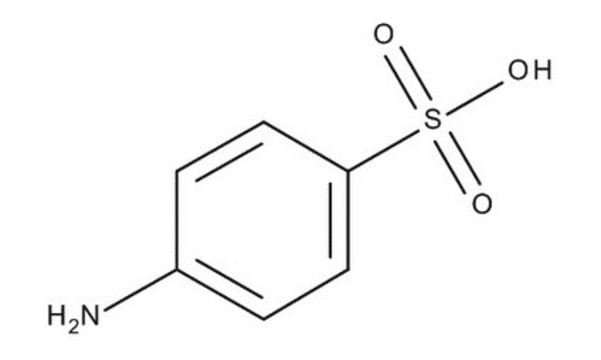251917
Sulfanilic acid
ACS reagent, 99%
Synonym(s):
4-Aminobenzenesulfonic acid, Aniline-4-sulfonic acid
About This Item
Recommended Products
grade
ACS reagent
Quality Level
assay
98.0-102.0% (ACS specification)
99%
form
powder
ign. residue
≤0.01%
mp
>300 °C (lit.)
anion traces
chloride (Cl-): ≤0.002%
nitrite (NO2-): ≤0.5 ppm
sulfate (SO42-): ≤0.01%
SMILES string
Nc1ccc(cc1)S(O)(=O)=O
InChI
1S/C6H7NO3S/c7-5-1-3-6(4-2-5)11(8,9)10/h1-4H,7H2,(H,8,9,10)
InChI key
HVBSAKJJOYLTQU-UHFFFAOYSA-N
Looking for similar products? Visit Product Comparison Guide
Application
signalword
Warning
hcodes
Hazard Classifications
Eye Irrit. 2 - Skin Irrit. 2 - Skin Sens. 1
Storage Class
13 - Non Combustible Solids
wgk_germany
WGK 1
flash_point_f
Not applicable
flash_point_c
Not applicable
ppe
dust mask type N95 (US), Eyeshields, Faceshields, Gloves
Choose from one of the most recent versions:
Already Own This Product?
Find documentation for the products that you have recently purchased in the Document Library.
Customers Also Viewed
Our team of scientists has experience in all areas of research including Life Science, Material Science, Chemical Synthesis, Chromatography, Analytical and many others.
Contact Technical Service











